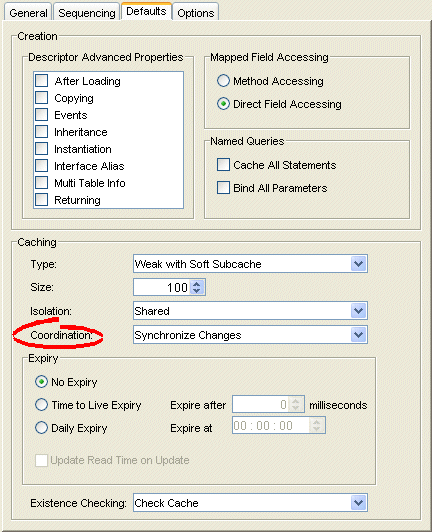|
Oracle TopLink Developer's Guide
10g Release 3 (10.1.3) B13593-01 |
|
 Previous |
 Next |
|
Oracle TopLink Developer's Guide
10g Release 3 (10.1.3) B13593-01 |
|
 Previous |
 Next |
If you plan to use a coordinated cache (see "Understanding Cache Coordination"), you can configure how and under what conditions a coordinated cache propagates changes.
Table 22-12 summarizes which projects support cache coordination change propagation configuration.
Table 22-14 Project Support for Cache Coordination Change Propagation Configuration
| Descriptor | Using TopLink Workbench
|
Using Java |
|---|---|---|
|
Relational Projects |
|
|
|
EIS Projects |
|
|
|
XML Projects |

|

|
The cache coordination change propagation options you configure at the project level apply globally to all descriptors. Use this section to define global options for a TopLink project.
You can override the project-level configuration by defining cache coordination change propagation options at the descriptor level. For information, see "Configuring Cache Coordination Change Propagation at the Descriptor Level".
To complete your coordinated cache configuration, see "Configuring a Coordinated Cache".
|
Note: When using TopLink Workbench, changing the project's default cache coordination change propagation option does not affect descriptors that already exist in the project; only newly added descriptors ar affected. |
To specify the coordinated cache change propagation options, use this procedure:
Select the project object in the Navigator.
Select the Defaults tab in the Editor. The Defaults tab appears.
Figure 22-12 Defaults Tab, Coordination Options

Use the following information to enter data in the Coordination field:
| Coordination Option | Description | When to Use |
|---|---|---|
| None | For both existing and new instances, do not propagate a change notification. | Infrequently read or changed objects. |
| Synchronize Changes | For an existing instance, propagate a change notification that contains each changed attribute.
For a new instance, propagate an object creation (along with all the new instance's attributes) only if the new instance is related to other existing objects that are also configured with this change propagation option. |
Frequently read or changed objects that contain few attributes or in cases where only a few attributes are frequently changed.
Objects that have many or complex relationships. |
| Synchronize Changes and New Objects | For an existing instance, propagate a change notification that contains each changed attribute.
For a new instance, propagate an object creation (along with all the new instance's attributes). |
Frequently read or changed objects that contain few attributes or in cases where only a few attributes are frequently changed.
Objects that have few or simple relationships. |
| Invalidate Changed Objects | For an existing instance, propagate an object invalidation that marks the object as invalid in all other sessions. This tells other sessions that they must update their cache from the data source the next time this object is read.
For a new instance, no change notification is propagated. |
Frequently read or changed objects that contain many attributes in cases where many of the attributes are frequently changed. |